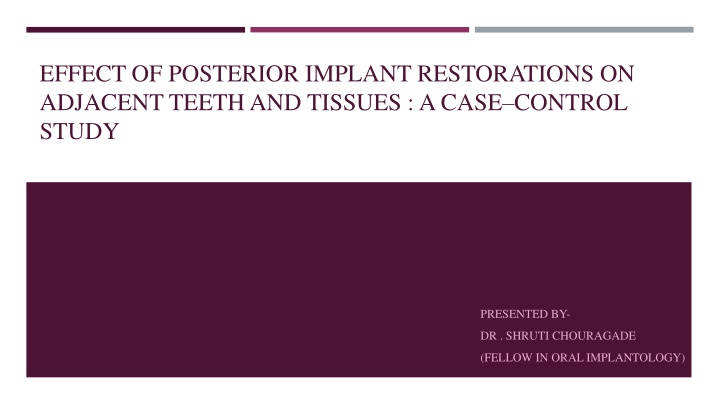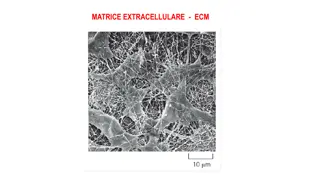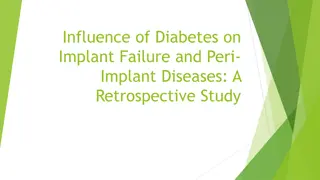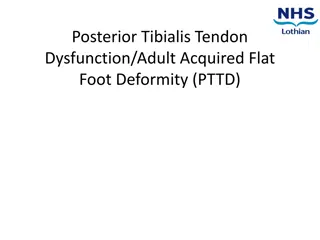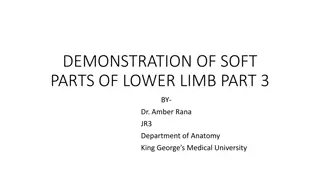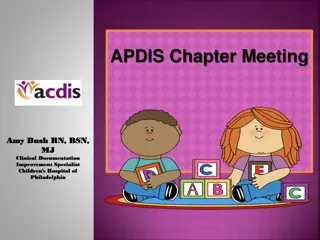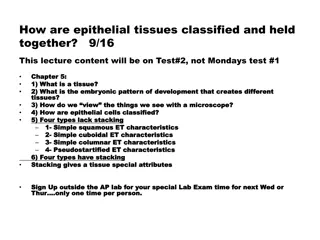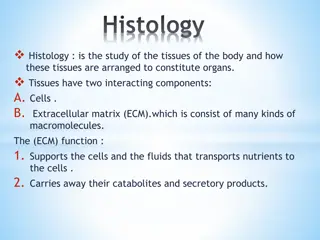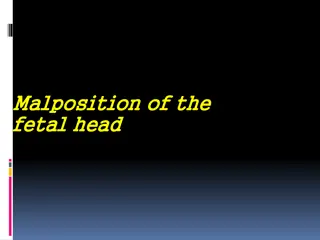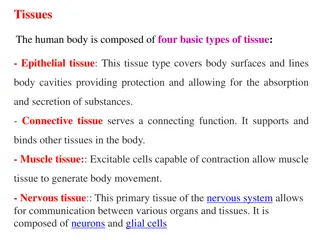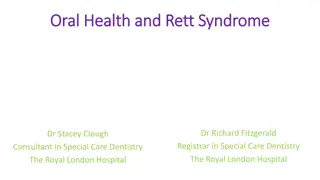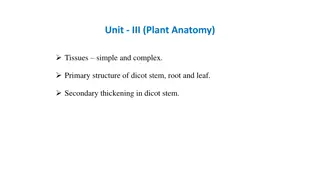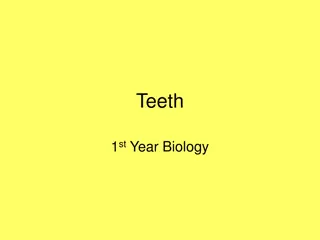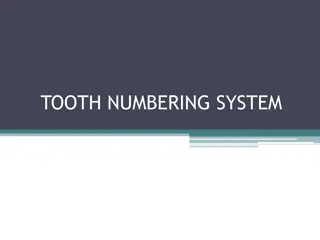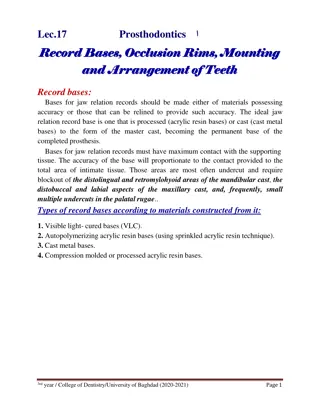Effect of Posterior Implant Restorations on Adjacent Teeth and Tissues: A Case Control Study
The study delves into the impact of posterior dental implant rehabilitation on adjacent natural teeth, exploring complications such as caries, cracks, fractures, and mobility. Factors such as proximal contact integrity, peri-implantitis effects, and occlusal load redistribution are considered. The objective is to analyze the effects of implant restorations on neighboring natural teeth, shedding light on potential risks and implications for dental implant therapy.
Download Presentation

Please find below an Image/Link to download the presentation.
The content on the website is provided AS IS for your information and personal use only. It may not be sold, licensed, or shared on other websites without obtaining consent from the author.If you encounter any issues during the download, it is possible that the publisher has removed the file from their server.
You are allowed to download the files provided on this website for personal or commercial use, subject to the condition that they are used lawfully. All files are the property of their respective owners.
The content on the website is provided AS IS for your information and personal use only. It may not be sold, licensed, or shared on other websites without obtaining consent from the author.
E N D
Presentation Transcript
EFFECT OF POSTERIOR IMPLANT RESTORATIONS ON ADJACENT TEETH AND TISSUES : A CASE CONTROL STUDY PRESENTED BY- DR . SHRUTI CHOURAGADE (FELLOW IN ORAL IMPLANTOLOGY)
Author : Nirit Tagger-Green (DMD, MSc, MHA) , Naama Fridenberg (DMD), Shani Segal (DMD), Shifra Levartovsky (DMD) , Amir Laviv (DMD, MPH) Source : Clinical Implant Dentistry and Related Research published by Wiley Periodicals LLC, 2023
INTRODUCTION: The need for rehabilitation of dental implants is constantly increasing as the aging population and life expectancy rise. Treatment with dental implants is valuable for improving both oral health and quality of life. While there are many studies on dental implants and rehabilitation, only a few studies examine their effects on adjacent teeth and tissue. There are several possible explanations for retreatment in teeth adjacent to implants compared to teeth adjacent to natural teeth.
One explanation is related to a possible change in the existence of proximal contacts and their strength between the restoration of the implant and the adjacent teeth. The lack of integrity of proximal contact may cause the area to be more prone to food impaction, which may expose the adjacent tooth to a higher risk of caries and periodontal disease Another explanation for the phenomenon could be the effect of peri-implantitis on the destruction of the gingiva and bone around the teeth adjacent to the implants, with worsening of periodontal pockets and adjacent teeth attachment loss. To reduce the occlusal load on the implants, the recommendation is to reduce the implant's occlusal table, thus reducing its biting forces. However, the direct result of reducing the occlusal load on the implant is increasing the occlusal load on the adjacent teeth since the implant is part of the patient's complete occlusal system. Increased load on the adjacent teeth can cause teeth cracks and fractures.
OBJECTIVE : The current study aims to analyze the effect of posterior dental implant rehabilitation on adjacent natural teeth.
MATERIALS AND METHODS : This retrospective study analyzed all patients' files treated in a single public dental clinic between January 9, 2010 and January 9, 2020 that were treated with dental implants in the posterior segment (either premolar or molar). The adjacent natural teeth were analyzed for five possible complications: primary caries, secondary caries (caries only in the proximal side facing the dental implant), tooth crack, tooth fracture, and tooth mobility. For patients with several implants in the mouth, which were found to have several complications in the teeth adjacent to the implants, a single complication was chosen for each patient the complication that occurred in the shortest period since the moment of implant rehabilitation.
INCLUSION CRITERIA: Patients at least 18 years old, treated with dental implants in a specific public clinic, and with well documented medical files. EXCLUSION CRITERIA: Files with missing clinical or radiographic data and patients with no teeth adjacent to the implants (patients with a full denture or total jaw implant fixed denture).
Data on the teeth adjacent to the dental implants were collected and divided into two groups, complication group versus no complication group, to search for possible predictors that could explain the complications in the teeth adjacent to the dental implant. In the routine of the public clinic, the patients come for a checkup every 6 months, in which two bite-wing x-rays are performed, and the findings of the clinical checkup are documented in the patient's chart, including oral hygiene, tooth mobility, food impaction, dental caries, contact point opening, and so forth. In the complication group further data extracted included: tooth number, the specific complication of the adjacent tooth, the time from dental implant rehabilitation to the appearance of the adjacent tooth complication, periodontal classification , tooth to implant distance (in the cementoenamel junction area), and dental implant diameter. The five different complications were further compared for the other specific variables. A p-value of <0.05 was considered statistically significant.
In the periodontal stagingthere was a total of 44.1% with mild disease (Stage 1), 40.2% with moderate disease (Stage 2), and 15.6% with severe disease (Stages 3 4). When comparing the different com plications, there was statistical significance tooth crack was found with periodontitis Stage 1 in 80% of the cases, whereas for tooth mobility, 60% of the patients were involved with periodontitis Stages 3 4 (p < 0.001). A higher number of implants was significant with tooth mobility complication, whereas a lower number was significant with cracked teeth (p = 0.002). Evaluating the distance between the implant and the adjacent tooth there was a statistical significance for primary caries (mean distance of 4.28 1.44) and tooth mobility (mean distance of 3.07 1.39), meaning, in higher distances between the implant and the tooth, there were more primary caries complications. In comparison, at lower distances, there were more tooth mobility complications (p = 0.04).
CONCLUSION : The current study found a relatively high rate of complications in teeth adjacent to dental implants. Secondary caries was the most common complication. Many complications can be prevented with a good understanding and the proper position of the implants. Understanding the possible complication will help the clinician to locate the implant better and thus to have a better prognosis for the implant and the surrounding teeth.
